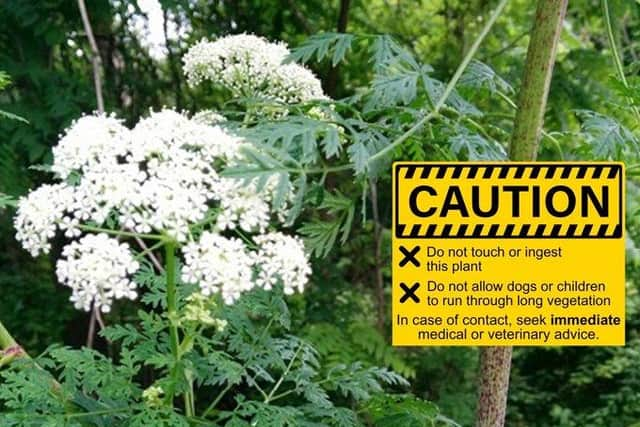Dog walkers warned after potentially fatal poisonous Hemlock found at Holywell Lakes in Peterborough
and live on Freeview channel 276
Dog walkers and other visitors are being warned to take extra care at Holywell Lakes in Peterborough after a poisonous plant was found there.
Poison Hemlock has been found at the Longthorpe site. The plant is highly toxic to humans and animals and can be fatal, and visitors are advised not to even touch it.
Advertisement
Hide AdAdvertisement
Hide AdHemlock poisoning occurs after ingesting any part of the plant. Both the growing and cut dried plant are poisonous. Its seeds, flowers, leaves, roots etc contain toxic alkaloids. These toxic alkaloids can be fatal to humans and animals, even in small amounts. Even touching the plant can cause a skin reaction.


There is no antidote for Hemlock poisoning.
In a social media post, councillor Wayne Fitzgerald said that sign posts would be put up at the site, warning people of the dangers of hemlock poisoning.
Peterborough City Council said that work was being undertaken to remove the plants – but eradicating it from the site completely could take five years.
Symptoms of Hemlock poisoning
The city council website has information on the symptoms of hemlock poisoning.
Advertisement
Hide AdAdvertisement
Hide AdThe council said: When touched, the plant can generate a painful rash or painful burning on the eyes if contact is made here.
Ingesting any part of the plant can lead to poisoning. This affects the nervous and respiratory systems and can lead to respiratory failure.
Symptoms include:
Trembling
Burning sensation in digestive tract
Increased salivation
Dilated pupils
Muscle pain and weakness
Decreased heart rate
Loss of speech
Convulsions
Unconsciousness
Seek medical attention immediately if you experience any symptoms or think you have come into contact with Poison Hemlock.
If possible, take a sample of the plant for identification if it is safe for you to do so. Use plastic gloves or a bag to avoid direct contact. If not, take some photographs.
Advertisement
Hide AdAdvertisement
Hide AdDo not try and make the patient sick. Help them to remain calm.
How to identify Poison Hemlock
Hemlock is a member of the carrot family. It looks similar to Cow Parsley with its big white flowers, tall slender stem and green leaves. However, there are some identifiable differences that are worth noting:
Hemlock has a smooth, green, hollow stem which is usually spotted or streaked with red, purple or pink on the top and lower half of the stem.
The plant grows tall, usually 1.5 to 2.5 metres (5 to 8 feet), but could reach heights of 3.5 metres (12 feet).
Advertisement
Hide AdAdvertisement
Hide AdHemlock produces umbrella-like clusters of white or cream flowers. The plant usually flowers in summer, not during spring or autumn. The non-flowering form has bright green leaves and the red, purple or pink spotting or streaking feature on the stem that the tall, flowering plant has.
The central stem has sets of two opposite branches with triangular feather-like leaves along these. The central stem itself is hairless and hollow. The plant has a long whitish taproot.
Unlike similar looking edibles, Hemlock has a distinctive unpleasant musty smell if the plant is damaged.
Hemlock can look very similar to other plants including carrots, parsnips, chervil and cow parsley.
Advertisement
Hide AdAdvertisement
Hide AdHemlock has a two-year lifecycle (growing from seed to fruition and then dying). However, the seeds can lay dormant and remain viable for three to five years.
If you notice Poison Hemlock growing on any public land owned or maintained by the council, please call 01733 747474 to report. The phone line is open Monday to Friday, 9am to 5pm.